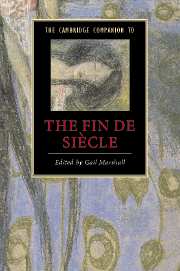Book contents
- Frontmatter
- Introduction
- 1 Psychology at the fin de siècle
- 2 Decadence and aestheticism
- 3 Sexual identity at the fin de siècle
- 4 Socialism and radicalism
- 5 Empire
- 6 Publishing industries and practices
- 7 The visual arts
- 8 The New Woman and feminist fictions
- 9 Realism
- 10 The fantastic fiction of the fin de siècle
- 11 Varieties of performance at the turn of the century
- 12 Poetry
- Guide to further reading
- Index
- Series List
8 - The New Woman and feminist fictions
Published online by Cambridge University Press: 28 September 2008
- Frontmatter
- Introduction
- 1 Psychology at the fin de siècle
- 2 Decadence and aestheticism
- 3 Sexual identity at the fin de siècle
- 4 Socialism and radicalism
- 5 Empire
- 6 Publishing industries and practices
- 7 The visual arts
- 8 The New Woman and feminist fictions
- 9 Realism
- 10 The fantastic fiction of the fin de siècle
- 11 Varieties of performance at the turn of the century
- 12 Poetry
- Guide to further reading
- Index
- Series List
Summary
In the first act of The New Woman, Sidney Grundy's satirical play from 1894, the audience is presented with a dispute between two contrasting but utterly characteristic New Woman figures from the fin de siècle, Enid Bethune and Victoria Vivash:
enid: Why should a man be allowed to commit sins -
victoria: And woman not be given an opportunity?
enid: Then you want to commit sins?
victoria: I want to be allowed to do as men do.
enid: Then you ought to be ashamed of yourself; there!
victoria: I only say, I ought to be allowed.
enid: And I say that a man, reeking with infamy, ought not to be allowed to marry a pure girl -
victoria: Certainly not! She ought to reek with infamy as well!
enid: Victoria!
Enid Bethune's disapproval of male sexuality and her desire for sexual chastity in both women and men firmly ally her with a social purity feminism that was highly influential in the late nineteenth century. Social purity feminists campaigned against prostitution and decadent male sexuality, and had amongst their number the leading New Woman novelist, Sarah Grand (Frances Elizabeth McFall, 1854-1943). Grundy's Victoria Vivash, by contrast, demands sexual parity between women and men, and wishes women to enjoy the same sexual freedoms as men. In the fictional field such a stance was supported by the popular writer of New Woman short stories, George Egerton (Mary Chavelita Dunne, 1859-1945). Both positions - as evidenced by the success of Sidney Grundy's theatrical spoof on the New Woman - provoked considerable controversy in the late-Victorian cultural sphere.
- Type
- Chapter
- Information
- The Cambridge Companion to the Fin de Siècle , pp. 153 - 168Publisher: Cambridge University PressPrint publication year: 2007
- 5
- Cited by

